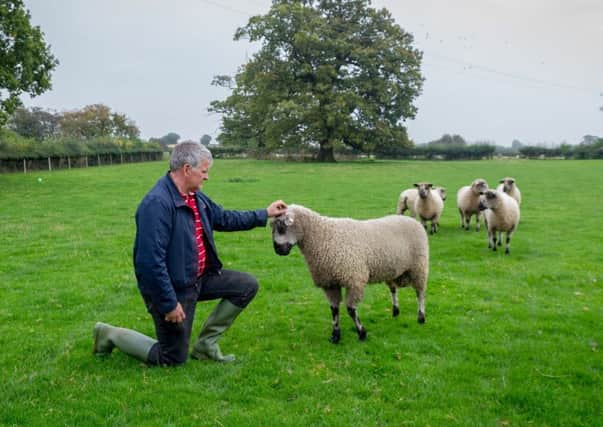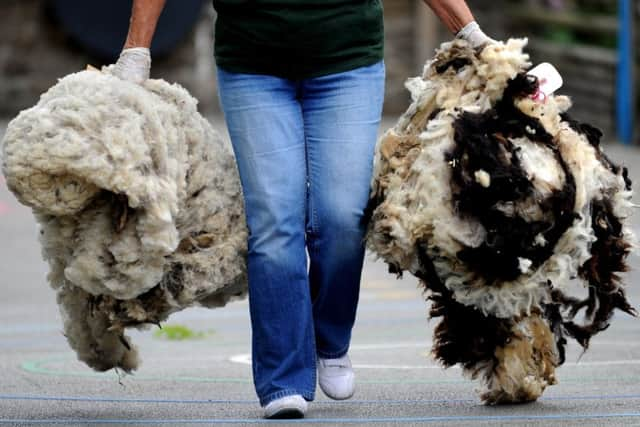Why fleeces are golden again


Recent decades have seen many flock owners despair over fleece prices and even this year payments featured by the British Wool Marketing Board see fleeces for some breeds as low as 28 pence per kilo.
There are huge variations between breeds due to their fine or coarse nature, their lustre and to be frank their quality, but even so the top price quoted is only £3.15 per kilo. Allowing for a fleece weight of between 4 to 6 kilos this means a fleece through normal sale channels can be worth as little as just over £1 and shearer charges this can be above the amount received.
Advertisement
Hide AdAdvertisement
Hide AdMark Elliott of Providence Farm, Ferrensby near Knaresborough is a renowned and respected sheep breeder and showman of pedigree Wensleydales and Teeswaters that top the fleece market.


He farms in partnership with his mum Judy and also runs Mashams and Mules, but he’s shifting his numbers around to accommodate more of his longwool sheep as he and his fellow Wensleydale, Teeswater and Masham colleagues are finding demand is bringing prices way in excess of the norm.
“Our wool price has taken off in the past three or four years as demand has grown from individual spinners and craft people. It’s not simply confined to the UK either. This year I’ve had two customers come to the farm from Germany, a lady from Russia and I’ve shipped to America. It’s not just me. All Wensleydale and Teeswater breeders are experiencing the same and none of us know how bottomless the market is, but we do understand that we could sell more than we have at present. I’m purely selling the raw wool and the prices have been great.
“Wensleydales and Teeswaters produce the finest lustre longwool in the world and there has always been a premium over other breeds but the recent rise in price has been unprecedented. In America they have tried breeding some of their own but the feeling is the quality of wool sourced here is better than can be produced over the pond. I’ve been selling recently at £20 per kilo but I know of others who have been earning above that and some are selling in 100 gram lots making a fleece worth considerably more.”
Advertisement
Hide AdAdvertisement
Hide AdSpinners’ demand has put a different spin on Mark’s calculations over which sheep to keep. He’s at his optimum for numbers on his acreage at Providence and so it’s a marginal shift away from the Mule and on to more longwools that he’s moved to this year.


“The sheep can now pay for themselves just from the fleeces and because the ewes can produce a quality annual saleable fleece for up to 10 years it’s a strong, sustainable regular income. I currently produce sheep to sell to other breeders, through the Wensleydales and Teeswaters; and fat lambs to sell at Pateley Bridge Auction Mart through the Mashams and Mules bought-in and put to the Texel tup, but I’ve started shifting to keep more sheep for the wool. I’ve twice-crossed some Mashams back to the Teeswater for the premium fleeces.
“That means I can sell a Masham fat lamb shorn and twice-crossed for a reasonable return plus take a decent return off the fleece before it goes.”
Mark’s successes in the show rings add to his reputation among spinners and last week he had reserve champion Wensleydale with his tup plus a first place and two third places with his Teeswaters at Nidderdale Show. He’s won many titles including several at the Great Yorkshire Show but it is the camaraderie he values most.
Advertisement
Hide AdAdvertisement
Hide Ad“I love showing but it’s the wonderful people I’ve met through doing it that is the main thing. If I win, I win; If I lose, I lose; it doesn’t really matter as it is just such a fantastic social time. I’ve always shown Wensleydales and I’ve now shown Teeswaters for the past 10 years since buying my first gimmer lamb from David Newbould in Dallowgill in 2008. They are both excellent breeds. The brown and white faced Wensleydale Masham was originally dominant but eventually fashion took over in favour of the black and white faced Teeswater Masham.
“I have a dozen pedigree Teeswater ewes; 22 pedigree Wensleydales; and lamb around 110 Mashams and Mules. We started with Wensleydales in 1945 when my dad John and his sister Freda bought two ewes each from a sale in the next village at Old Hall, Farnham.
“After acquiring additional ewes from Arthur Jackson of Longridge near Preston in the 1950s they never added another. Everything in the Providence flock today can be traced back to those early days.”
Providence Farm runs to 140 acres with 65 acres down to grass and the rest arable with all of the non-livestock work handled by local agricultural contractors.
“I sell everything at Wharfedale Farmers Auction Mart in Otley and have one butcher, Paul Leadbeater of Cross Roads, Keighley who buys nearly all of mine as I get them to his favoured weight.”